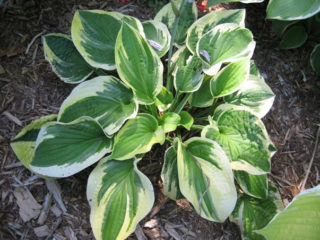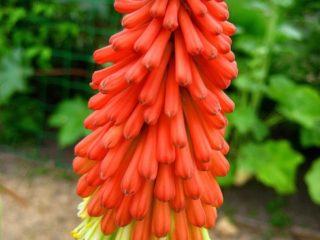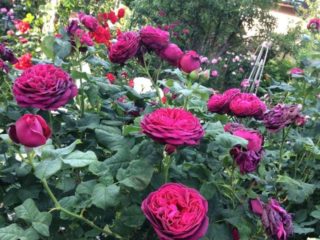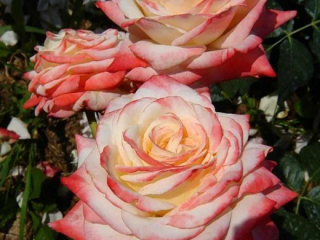Content
Pyrethrum flower is a rhizomatous herbaceous perennial, better known as Dalmatian or Persian chamomile. It is valued for its bright and large inflorescences and contains parthenolide, which is actively used in folk and official medicine.
Description of the pyrethrum flower with photo
The genus Pyrethrum unites several dozen species of herbaceous perennials from the Asteraceae family, growing in North Africa, Asia and Europe. The plants are dense, dense shrubs with a powerful root system penetrating up to 3 m deep, and numerous erect or ascending branched ribbed pubescent shoots.

The Latin name of the genus comes from the Greek word pyretos, translated meaning “fever”, “heat”
The stems of Dalmatian (Persian) chamomile stretch up to 60-100 cm. They are covered with alternate leaves, dissected into narrow segments of unequal width. The front surface of the plates is gray-green, the back is ash-gray. The basal leaves of Persian (Dalmatian) chamomile are attached to long grooved petioles.
When and how long does pyrethrum bloom?
Flowering of Persian (Dalmatian) chamomile begins in May or June and lasts for a month. During this period, the plant is covered with small basket flowers, collected in corymbose apical inflorescences. The marginal reed flowers of the Persian chamomile are sterile, the tubular middle ones are bisexual.
At the end of the flowering time of pyrethrum, pale brown achenes form in place of the inflorescences. They are lobed or serrated and contain grains that remain viable for 24-36 months.
Frost resistance of pyrethrum
The flower is characterized by high cold resistance and belongs to USDA zone 3. Dalmatian (Persian) chamomile tolerates temperature drops down to -29-34 0C and needs shelter only in snowless winters.
Useful properties and uses of pyrethrum
People knew how to use pyrethrum in ancient times. The first mentions of the miraculous properties of chrysanthemum powder date back to the 1st millennium BC. e. The Chinese used it to control pests.The ancient Romans and the soldiers of Alexander the Great used crushed Persian (Dalmatian) chamomile as a natural insecticide to repel lice, fleas and ticks. The powder prepared from the flower was sprinkled on things and rubbed on the head and body.

The scientific basis for the insecticidal properties of pyrethrum was made in the XX century. after isolating pyrethrins and confirming their harmful effects on insects
Dalmatian chamomile has long been used in alternative medicine. The ability of the flower to heal severe fever was first described by the Greek herbalist Dioscorides in Art. n. e. Persian chamomile (especially in flowers and fruits) contains essential oils, flavonoids and more than 80% parthenolide. This organic compound has pronounced anti-inflammatory properties and prevents the release of serotonin, which affects the constriction/dilation of blood vessels, providing an anti-migraine effect.
Persian chamomile products help with:
- ringing in the ears;
- nausea;
- asthma;
- colitis
They provide relief from painful and irregular menstruation, thin the blood and minimize the risk of blood clots.

Pyrethrum flower is used in the complex treatment of hypertension, rheumatism, dermatitis, scabies and psoriasis
Types and varieties of pyrethrum
According to various sources, the genus Pyrethrum includes from 40 to 100 species, as well as many garden forms and varieties. But gardeners grow no more than a couple of dozen varieties of Dalmatian chamomile.
Pyrethrum is beautiful
A rhizomatous, rosette perennial with few poorly leafy, erect shoots covered with an edge of sinuous fibers. The height of the beautiful pyrethrum is 45-50 cm, and the length of the leaves reaches 15 cm. The twice pinnately dissected basal plates are attached to long petioles, the stem ones are sessile. The baskets are single or form inflorescences of 2-3 pieces. Reed flowers are white, tubular flowers are gray. Beautiful pyrethrum grows in Siberia, Central Asia, Northern Mongolia, Kazakhstan and Northern China.

Beautiful pyrethrum is found in the tundra, on rocky landscapes and slopes near glaciers
Pyrethrum macrophylla
A tall perennial, the stems of which stretch up to 1-1.5 m, grows in the Caucasus and has corymbose inflorescences with a circumference of 10 cm. The latter are formed by small white flowers, gradually acquiring a brownish-red tint.

Pyrethrum large-leaved looks impressive in group plantings next to reed grass, variegated miscanthus and switchgrass
Pyrethrum corymboses
A rhizomatous perennial with several or one erect stem, branched at the apex, stretching up to 40-150 cm. The pinnately dissected basal leaves are long-petioled, the stem leaves are short and sessile. Loose corymbose inflorescences are formed by 15-20 baskets supported on rather long fleecy stalks. The reed flowers are painted white, the achenes are gray.

In the wild, pyrethrum corymboses is found in Eastern Europe, the foothills of the Altai and the Caucasus.
Pyrethrum cinerarifolia or Dalmatian chamomile
The dwarf variety, 15-45 cm high, has double or triple pinnately dissected leaves, colored bluish-green.The flower heads of the Dalmatian chamomile are formed by pale yellow marginal and gray tubular flowers.

The marginal flowers of the Dalmatian chamomile can be painted white
Red or Caucasian chamomile
The perennial, native to the Caucasus, comes in many forms with ray flowers colored in different shades. Their color varies from white to dark cherry.

Caucasian chamomile is often confused with pink pyrethrum
The most popular form of red pyrethrum is Robinson's Giants. The plant is a tall bush about 80 cm high and has large chamomile-like inflorescences with pink and carmine petals.

The variety Robinson's Giants looks equally impressive in flower beds and bouquets.
Pink or Persian daisy
A rhizomatous perennial with erect shoots stretching up to 60-70 cm and covered with dissected pale green leaves. The baskets of Persian chamomile grow with a diameter of about 50 mm and can be single or collected in clusters of 2-3 pieces.

Persian chamomile has many varieties and garden forms.
Harmony is considered one of the most popular varieties of pink pyrethrum. This tall perennial, approximately 70 cm high, has terry baskets colored red.

Pink pyrethrum Harmony blooms from mid-June to August
Pyrethrum Crimson giants is no less popular among gardeners. This is an unpretentious perennial with graceful feathery leaves and bright daisy-like flowers.

Pyrethrum variety Raspberry giants is characterized by high cold and drought resistance
How to plant pyrethrum
There are two ways to grow pyrethrum from seeds: seedlings and sowing directly into unprotected soil.To preserve the varietal characteristics of the flower, it is better not to collect the seed material yourself, but to buy it in a specialized store. Since the seeds of Dalmatian (Persian) chamomile are very small, it is more convenient to sow pyrethrum by first mixing them with sand.
Selection of location and soil
Dalmatian chamomile prefers open, well-lit and well-drained areas. The flower should not be planted in lowlands and under trees, where the sun practically does not reach.
The soil in the area allocated for planting pyrethrum should be fertile and loose. It is important that it drains water well and has a neutral or alkaline pH level. If the soil on the site is clayey, it is mixed with a large amount of sand.

When sowing Persian chamomile in acidified soil, the flower will grow frail
Seed treatment
Before sowing pyrethrum seeds, they are soaked for 3-5 hours in water at room temperature with the addition of any biostimulant, for example, Epin. To protect developing plants from infections, several crystals of potassium permanganate or a fungicide are dissolved in water.
Sowing technology
When grown by seedlings, Dalmatian chamomile seeds are sown in March. Sowing directly into open ground is carried out in May, when the threat of return frosts has passed and consistently warm weather has established. The seeds are evenly distributed over the surface of pre-moistened soil and covered with a layer of earth 2-3 mm thick. The crops are covered with film and wait for the emergence of shoots. At a temperature of +18 0The sprouts will hatch within three weeks.
Caring for pyrethrum in the garden
Dalmatian (Persian) chamomile is not the most difficult crop to grow.Caring for a flower is quite simple and involves performing standard agrotechnical manipulations.
Watering
An important characteristic of pyrethrum is drought resistance. Thanks to this, the flower is able to be content with moisture received in the form of precipitation. If Persian chamomile does not have enough water, its leaves begin to droop. Therefore, during the flowering period or in the absence of rain for a long time, the flower must be watered. To do this, use settled, non-cold water so as not to provoke temperature shock and damage to the roots.
To slow down the evaporation of moisture, the soil under the pyrethrum is covered with a layer of mulch. To do this, use sawdust, pine needles, wood chips, fallen leaves, straw, grass clippings or garden compost. Mulch not only retains moisture in the soil longer, but also slows down the growth of weeds.
Feeding
Pyrethrum responds well to the application of organic fertilizers, such as rotted manure. The flower is fed 2-3 times per season. This is done for the first time during the budding period. At this stage, the flower is fed with potassium and phosphorus compounds. The second time, universal mineral fertilizer is applied to the soil under the Dalmatian chamomile. At the very beginning of autumn, pyrethrum is watered with a decoction of weeds.

If Persian chamomile is overfed with nitrogen, it will begin to actively grow green mass and will not bloom profusely
Pruning and wintering
Tall and not particularly strong stems of Dalmatian chamomile are tied to a support if necessary. As for pruning, it’s enough just to pick off the wilted buds in time. In order for pyrethrum to bloom for the second time in a season, at the end of flowering, before the seeds begin to ripen, all flower shoots are cut off from the bush.
Although Persian chamomile is characterized by high cold resistance, it must be prepared for winter.In mid-autumn, before the first frost, green fragments are cut from the bush, and the remaining roots in the ground are sprinkled with peat or fallen leaves.
Diseases and pests
Dalmatian (Persian) chamomile has a relatively strong immune system and is immune to most diseases and pests. Problems with flowers begin mainly due to errors in care. If the rules of agricultural technology are violated, Dalmatian chamomile is affected by fusarium or gray rot. Both diseases are fungal in nature and involve above-ground fragments of pyrethrum. The affected flower becomes covered with a gray fuzzy coating, gradually loses its foliage and eventually dies. Diseased Persian chamomile is uprooted along with the roots and burned, and the bed is generously watered with a fungicide solution.
Fusarium develops when the root system of pyrethrum is damaged by pathogenic bacteria that destroy the flower from the inside. It cannot be treated and can spread to neighboring crops. To prevent this from happening, the diseased Dalmatian chamomile is uprooted and destroyed, and the soil is spilled with fungicide.

Fundazol is a broad-spectrum contact fungicide, effective against gray mold and fusarium.
Of the pests, Dalmatian chamomile is most often attacked by slugs. They eat the foliage of the pyrethrum, and within a couple of nights, stems with “stubs” of greenery remain from the bush. They are collected by hand or poultry is “attracted” to this activity.

Slugs are gastropods that feed on the foliage and fruits of vegetables and flowers.
Methods for propagating pyrethrum
All varieties and types of Dalmatian (Persian) chamomile are propagated not only by seeds, but also in other ways:
- Dividing the bush.A healthy flower is carefully dug up, shaken off the soil and, using a knife, cut into several parts so that each has a small fragment of root and at least one shoot. The resulting divisions are planted in pre-dug and spilled holes, covered with earth and watered. The division of the Persian (Dalmatian) chamomile bush is carried out in the spring, before flowering begins, or in the fall, after its completion.
- By cuttings. Both stem and root cuttings are suitable for this. They are germinated in a glass of water, and after the roots appear, they are planted in the ground. Dalmatian (Persian) chamomile can be propagated by cuttings throughout the summer.
Pyrethrum in landscape design
Persian chamomile is successfully used to decorate country-style plots, edging the main flower bed, and decorating borders and paths.

Pyrethrum goes well with poppies, bluebells, cornflowers and ordinary garden daisies

Marigolds, cinerarias, marigolds, doronicums and felicias will be excellent neighbors for the flower.
Persian chamomile is often planted along sidewalks, next to trees and ornamental shrubs. The flower is also used to decorate verandas, loggias and terraces.
Conclusion
Pyrethrum flower is a lush, profusely blooming perennial, actively used in landscape and floral design. It has long been famous for its unique healing properties and is able to repel some insects.
Reviews of the perennial flower pyrethrum








